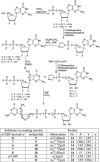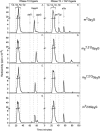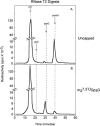Novel "anti-reverse" cap analogs with superior translational properties
- PMID: 12923259
- PMCID: PMC1370475
- DOI: 10.1261/rna.5430403
Novel "anti-reverse" cap analogs with superior translational properties
Abstract
Synthetic analogs of the 5'-terminal caps of eukaryotic mRNAs and snRNAs are used in elucidating such physiological processes as mRNA translation, pre-mRNA splicing, intracellular transport of mRNA and snRNAs, and mRNA turnover. Particularly useful are RNAs capped with synthetic analogs, which are produced by in vitro transcription of a DNA template using a bacteriophage RNA polymerase in the presence of ribonucleoside triphosphates and a cap dinucleotide such as m(7)Gp(3)G. Unfortunately, because of the presence of a 3'-OH on both the m(7)Guo and Guo moieties, up to half of the mRNAs contain caps incorporated in the reverse orientation. Previously we designed and synthesized two "anti-reverse" cap analogs (ARCAs), m(7)3'dGp(3)G and m(2)(7,3'-)(O)Gp(3)G, that cannot be incorporated in the reverse orientation because of modifications at the C3' position of m(7)Guo. In the present study, we have synthesized seven new cap analogs modified in the C2' and C3' positions of m(7)Guo and in the number of phosphate residues, m(2)(7,2'-)(O)Gp(3)G, m(7)2'dGp(3)G, m(7)2'dGp(4)G, m(2)(7,2'-)(O)Gp(4)G, m(2)(7,3'-)(O)Gp(4)G, m(7)Gp(5)G, and m(2)(7,3'-)(O)Gp(5)G. These were analyzed for conformation in solution, binding affinity to eIF4E, inhibition of in vitro translation, degree of reverse capping during in vitro transcription, capping efficiency, and the ability to stimulate cap-dependent translation in vitro when incorporated into mRNA. The results indicate that modifications at C2', like those at C3', prevent reverse incorporation, that tetra- and pentaphosphate cap analogs bind eIF4E and inhibit translation more strongly than their triphosphate counterparts, and that tetraphosphate ARCAs promote cap-dependent translation more effectively than previous cap analogs.
Figures






Similar articles
-
Synthesis of anti-reverse cap analogs (ARCAs) and their applications in mRNA translation and stability.Methods Enzymol. 2007;431:203-27. doi: 10.1016/S0076-6879(07)31011-2. Methods Enzymol. 2007. PMID: 17923237 Review.
-
Novel cap analogs for in vitro synthesis of mRNAs with high translational efficiency.RNA. 2004 Sep;10(9):1479-87. doi: 10.1261/rna.7380904. RNA. 2004. PMID: 15317978 Free PMC article.
-
Phosphorothioate cap analogs stabilize mRNA and increase translational efficiency in mammalian cells.RNA. 2007 Oct;13(10):1745-55. doi: 10.1261/rna.701307. Epub 2007 Aug 24. RNA. 2007. PMID: 17720878 Free PMC article.
-
Differential inhibition of mRNA degradation pathways by novel cap analogs.J Biol Chem. 2006 Jan 27;281(4):1857-67. doi: 10.1074/jbc.M509121200. Epub 2005 Oct 28. J Biol Chem. 2006. PMID: 16257956
-
Potential therapeutic applications of RNA cap analogs.Future Med Chem. 2013 Jun;5(10):1141-72. doi: 10.4155/fmc.13.96. Future Med Chem. 2013. PMID: 23795970 Review.
Cited by
-
Affinity resins containing enzymatically resistant mRNA cap analogs--a new tool for the analysis of cap-binding proteins.RNA. 2012 Jul;18(7):1421-32. doi: 10.1261/rna.032078.111. Epub 2012 May 15. RNA. 2012. PMID: 22589334 Free PMC article.
-
Supercoiled DNA percentage: A key in-process control of linear DNA template for mRNA drug substance manufacturing.Mol Ther Nucleic Acids. 2024 May 20;35(2):102223. doi: 10.1016/j.omtn.2024.102223. eCollection 2024 Jun 11. Mol Ther Nucleic Acids. 2024. PMID: 38948330 Free PMC article.
-
mRNA-based therapeutics: powerful and versatile tools to combat diseases.Signal Transduct Target Ther. 2022 May 21;7(1):166. doi: 10.1038/s41392-022-01007-w. Signal Transduct Target Ther. 2022. PMID: 35597779 Free PMC article. Review.
-
Dinucleoside polyphosphates act as 5'-RNA caps in bacteria.Nat Commun. 2020 Feb 26;11(1):1052. doi: 10.1038/s41467-020-14896-8. Nat Commun. 2020. PMID: 32103016 Free PMC article.
-
mRNA-based therapeutics--developing a new class of drugs.Nat Rev Drug Discov. 2014 Oct;13(10):759-80. doi: 10.1038/nrd4278. Epub 2014 Sep 19. Nat Rev Drug Discov. 2014. PMID: 25233993 Review.
References
-
- Adams, B.L., Morgan, M., Muthukrishnan, S., Hecht, S.M., and Shatkin, A.J. 1978. The effect of “cap” analogs on reovirus mRNA binding to wheat germ ribosomes. J. Biol. Chem. 253: 2589–2595. - PubMed
-
- Beelman, C.A., Stevens, A., Caponigro, G., LaGrandeur, T.E., Hatfield, L., Fortner, D.M., and Parker, R. 1998. An essential component of the decapping enzyme required for normal rates of mRNA turnover. Nature 382: 642–646. - PubMed
-
- Blaedel, W.J. and Meloche, V.W. 1963. Elementary quantitative analysis: Theory and practice, p. 640. Harper & Row, New York.
-
- Cai, A., Jankowska-Anyszka, M., Centers, A., Chlebicka, L., Stepinski, J., Stolarski, R., Darzynkiewicz, E., and Rhoads, R.E. 1999. Quantitative assessment of mRNA cap analogs as inhibitors of in vitro translation. Biochemistry 38: 8538–8547. - PubMed
-
- Calero, G., Wilson, K.F., Ly, T., Rios-Steiner, J.L., Clardy, J.C., and Cerione, R.A. 2002. Structural basis of m7GpppG binding to the nuclear cap-binding protein complex. Nat. Struct. Biol. 9: 912–917. - PubMed
Publication types
MeSH terms
Substances
Grants and funding
LinkOut - more resources
Full Text Sources
Other Literature Sources
Miscellaneous
